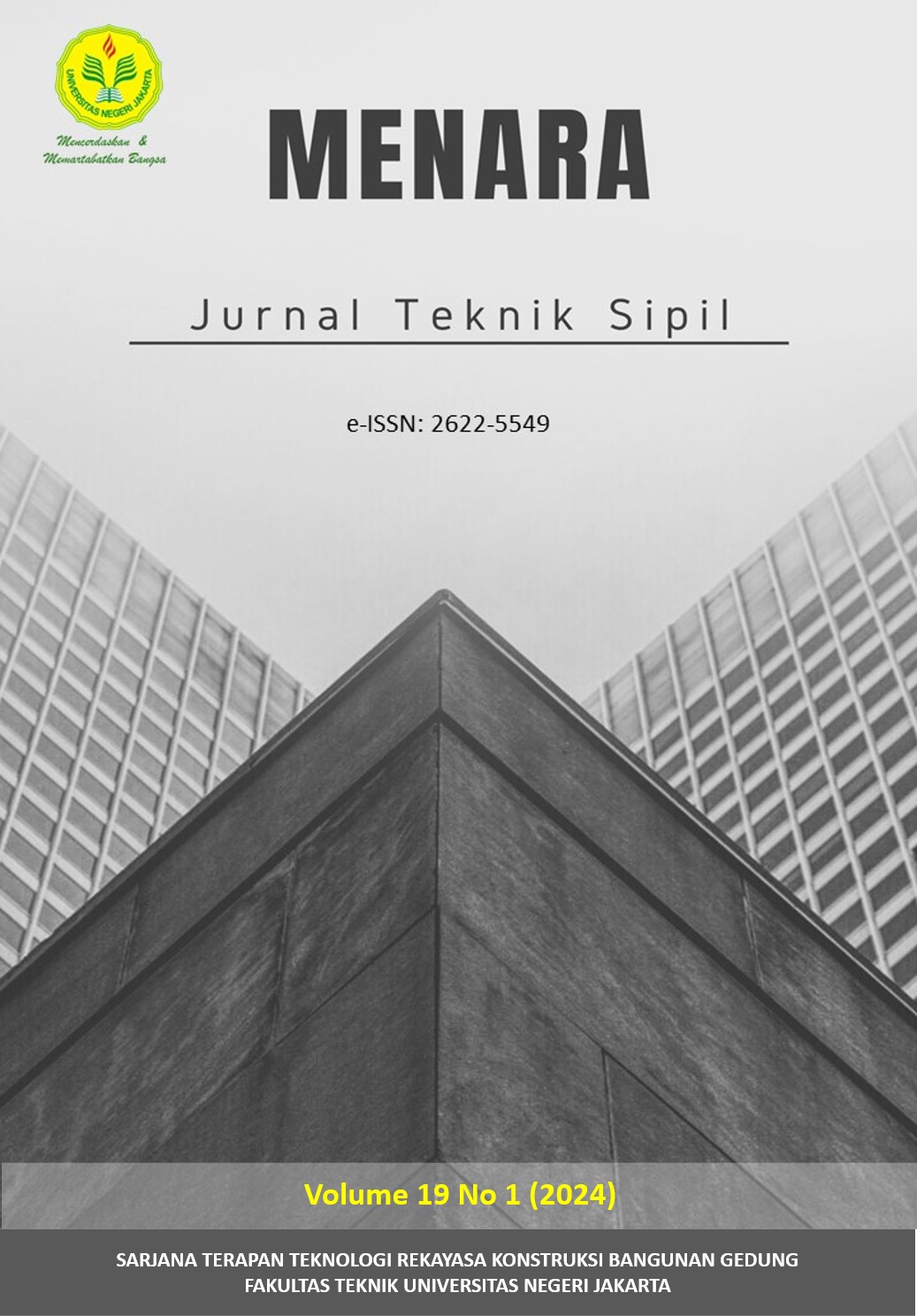FLEXURAL CAPACITY OF REINFORCED CONCRETE BEAMS WITH CIRCULAR OPENINGS AND REINFORCEMENT DETAILING IN COMPRESSION AND TENSION ZONES
DOI:
https://doi.org/10.21009/jmenara.v19i1.37454Keywords:
Bukaan Lingkaran, Daerah Tekan dan Daerah Tarik, Detailling Perkuatan, Kapasitas LenturAbstract
The pipes placed below the beams are intended for aesthetic purposes and are subsequently covered by the ceiling, resulting in an unused space. The height of this space will always be determined by the size of the pipes installed below the beams. One alternative plan to route the piping installations above is by creating circular holes with detailing in the beams. The testing conducted in this study involved the flexural testing of beams with simple supports. The concrete beams used as the flexural test specimens were sized at (10 x 15 x 100) cm. The research results indicate that the capacity of the beams increased due to the presence of holes in the tensile and compressive areas. In terms of percentage, when compared to the control beam, the flexural capacity increased by 13% for BBTE1, 4.425% for BBTE2, 6.667% for BBTA1, and 5.607% for BBTA2. The observation of crack patterns revealed that overall failure in the beams occurred through flexural failure for beams BN, BBTE1, BBTE2, BBTA1, and shear failure for beam BBTA2.
References
Ade Lisantono, H.Y.W. (2007) ‘Pengaruh Dimensi Bukaan Terhadap Kuat Lentur dan Geser Balok Beton Bertulang Dengan Bukaan Ganda’, Jurnal Teknik Sipil, Volume 8(No. 1), pp. 37–52.
Al-sheikh, S.A. (2014) ‘Flexural Behavior of Rc Beams With Opening’, Concrete Research Letters, 5(2), pp. 812–824.
Allam, S.M. (2005) ‘Strengthening of RC beams with large openings in the shear zone’, AEJ - Alexandria Engineering Journal, 44(1), pp. 59–78.
El Ame, F., Mwero, J.N. and Kabubo, C.K. (2020) ‘Openings Effect on the Performance of Reinforced Concrete Beams Loaded in Bending and Shear’, Engineering, Technology & Applied Science Research, 10(2), pp. 5352–5360.
Badan Standarisasi Nasional Indonesia (2013) ‘SNI 2847:2013 Persyaratan Beton Struktural untuk Bangunan Gedung’, Bsn, p. 265.
M.K, E.-S., H.A., E.-El. and M.S, E. (2018) ‘Experimental and Analytical Study of Strengthening Reinforced Concrete Beams with Openings’, 13(7), pp. 4934–4950.
Mansur, M.A. (2006) ‘Design of Reinforced Concrete Beams with Web Openings’, Proceedings of the 6th Asia-Pacific Structural Engineering and Construction Conference, (September), pp. 5–6.
Muhammad Wildan Ubaidillah and Djati, E. walujo (2022) ‘Eksperimen Uji Lentur Balok Beton dengan Bundel Tulangan’, Jurnal Konstruksi, 20(1), pp. 202–213.
Prihantono (2012) ‘Studi Perbandingan Sambungan Balok ¼ , ½ Bentang Dan Utuh Pada Saat Pengecoran Terhadap Kekuatan Balok Beton Prihantono’, Jurnal Menara Teknik Sipil, VII(1), pp. 126–144.
Sarah, J., Farzad, H. and Nima, O. (2019) ‘Effect of Using High-Strength Concrete and Ultra-High-Performance Concrete Material on Reinforced Concrete Beam with Opening under Flexural Load’, IOP Conference Series: Earth and Environmental Science, 357(1).
SNI 1974 (2011) ‘SNI 1974-2011 Cara Uji Kuat Tekan Beton dengan Benda Uji Silinder’, Badan Standardisasi Nasional Indonesia, p. 20.
SNI 2052-4841 (2014) ‘SNI 2052-4841-2014 Baja tulangan beton’, p. 15.
Wijaya, H.S. (2017) ‘Pengaruh Bukaan (Opening) Terhadap Kapasitas Lentur Balok Beton Bertulang’, Jurnal Media Teknik Sipil, 15(1), p. 42.
Downloads
Published
Issue
Section
License
Copyright (c) 2023 Ghalib Setyo Budi, Mohamad Galuh Khomari, Dadang Dwi Pranowo, M. Shofi’ul Amin, Eva Olivia Hutasoit

This work is licensed under a Creative Commons Attribution-ShareAlike 4.0 International License.
Authors who publish with this Journal agree to the following terms:
- Author retain copyright and grant the journal right of first publication with the work simultaneously licensed under a creative commons attribution licensethat allow others to share the work within an acknowledgement of the work’s authorship and initial publication of this journal.
- Authors are able to enter into separate, additional contractual arrangementfor the non-exclusive distribution of the journal’s published version of the work (e.g. acknowledgement of its initial publication in this journal).
- Authors are permitted and encouraged to post their work online(e.g. in institutional repositories or on their websites) prior to and during the submission process, as it can lead to productive exchanges, as well as earlier and greater citation of published works.











